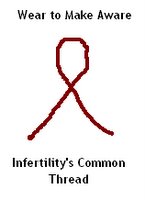Choosing a Sperm Donor
By DI Mom
Why Would You Be Using a Sperm Donor?
Those most likely to use a sperm donor are heterosexual couples with male-factor infertility, lesbian couples, and single mothers by choice (SMBC).
[Remember that many people fall into the male-factor category including those who knew prior to trying-to-conceive that they would have trouble producing sperm including those who have a prior history of cancer, spinal cord injury, or a genetic illness. Some people who can produce sperm but are carriers of a genetic illness may choose to use donor sperm in order to not pass along those genes--Mel]
What to Expect?
The first step is usually to meet with a reproductive endocrinologist (RE). Your RE will perform various blood tests and ultrasounds on you, and your partner if necessary, to confirm the cause of the infertility, to rule out any STDs, and to verify that your cycle and hormone levels are with a normal range. You may also be required to undergo a psychological assessment.
You then need to select the sperm donor that you would like to use. The first decision is do you want a known donor that is chosen by you or do you want to use a donor from a cryobank?
Some women feel very strongly that the donor have a genetic tie to her partner. In this case, the couple may approach a male relative and ask him to be a donor. The other option is to ask a family friend to be a donor. If this is the path that you choose, you should consider what tests should be performed to verify your donor’s health, how utilizing a known donor may affect future family dynamics, and other unique challenges that may arise. Your RE can suggest various tests and resources if you prefer this route.
If you decide that you would prefer to use a more anonymous cryobank (AKA sperm bank), there are various levels of service that you should consider before you choose your bank. For example, some banks participate in an “open donor” program in which information about your donor may be released when your child turns 18. Others do not require that you be under a physician’s care, if you decide that you would prefer to perform the insemination at home. Many have online support groups for their clients. Some provide photos of the donors as children or audio of interviews with the donor. Once you determine which cryobank you would like to use, it is time to choose your donor.
All of the larger cryobanks have their donor list available in a searchable online document. Before you begin, it is helpful if you choose which characteristics and traits are important to you. If you are unsure if you will disclose to your child about your use of donor insemination (DI), you may wish to choose based on your partner (i.e. height, weight, eye color, hair color and type, blood type, etc.). Also, you can eliminate donors with a genetic history that you feel is problematic such as cancer or alcoholism. Many banks will perform photo matching where you submit a photo of your partner and they will suggest donors who have similar features.
You will also need to choose the specimen type, Intracervical Insemination (ICI) or Intrauterine Insemination (IUI). Discuss with your RE the pros and cons of the two types.
Once you have selected your donor, the next step is usually to contact the cryobank and place your order. You may have to pre-register with the cryobank so allow yourself enough time for the paperwork to be processed. Your order will then be delivered in a special nitrogen tank (dewar) and your doctor will help you determine your insemination date and time based on your ovulation cycle.
Problems that May Arise and Ways to Troubleshoot
The donor that you choose may be very popular, especially if he has reported pregnancies, so it is a good idea to have several alternatives in mind in case your top pick is not available. Also, cryobanks will keep specimens in quarantine for several months while some of the tests are run so a donor that is not available for your current cycle may be available for subsequent cycles. You can always ask the cryobank how many specimens are in quarantine and when is the expected release date.
Chart your ovulation date for several months prior to your insemination cycle so that your order will arrive at the appropriate time.
Personal Tips
Read over the personal tips that are in the Choosing a Donor Egg write-up. Most also apply to using donor sperm.
Before you begin, check with your insurance provider regarding what fertility tests and treatments they will cover. Get everything in writing and know the appeals process in the event your claim is denied.
Think ahead. If you think that you may want more than one child and it is important to you that they be genetically related, choose a donor with plenty of specimens available. When you become pregnant, you may purchase additional specimens and have them stored at the cryobank until you need them. If the specimens never leave the cryobank, you may be able to be refunded some of your money if you later decide that you no longer need them but check with your bank as to their specifics.
Depending on which bank you use, the type of specimen (ICI or IUI), whether you are under a doctor’s care or are performing the insemination at home, and other factors, one DI cycle will likely cost $1000-$5000. Before you begin, you should honestly assess your financial situation and determine how many cycles you can afford. Success rates are difficult to determine but are usually quoted as being around 10%. Some will become pregnant on the first try and others will require 12 cycles or more. You will need to decide what is right for you.
If you would like to read more about the in-and-outs of donor insemination, I highly recommend Helping the Stork: The Choices and Challenges of Donor Insemination by Carol Vercollone, Heidi Moss, and Robert Moss (Wiley, 1997).
The Daily News
LFCA Latest Issue: Friday, September 25, 2009.
Latest Post on BlogHer: Parenting after Infertility.
My Status: Fed Josh's almonds to the squirrels. They needed them very badly.
LFCA Latest Issue: Friday, September 25, 2009.
Latest Post on BlogHer: Parenting after Infertility.
My Status: Fed Josh's almonds to the squirrels. They needed them very badly.
Wednesday, July 26, 2006
Subscribe to:
Post Comments (Atom)



























No comments:
Post a Comment